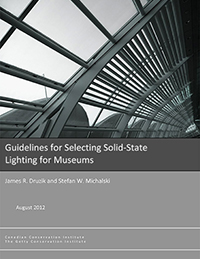
|
|
James R. Druzik and Stefan W. Michalski, 2012
A publication of the Canadian Conservation Institute and The Getty Conservation Institute
In the early 2000s LED lighting was little more than a hardware store novelty. At the time, one museum lighting specialist noted, LEDs didn't shine; they barely glowed. Coupled with poor color rendering, unknown stability, and unpredictable lifespan it is hard to imagine a less auspicious debut. In the years since, LEDs have evolved to begin taking a respected place in museum displays.
As with any paradigm shift, these changes come with uncertainty and many questions. Facilities managers are attracted by the claims of energy efficiency yet ask, given the cost per lamp, is cost recovery realistic. Conservators are resistant to exposing the most sensitive artifacts to new light sources. Curators wonder if the color quality of LEDs is up to the task of communicating an aesthetic message as well as daylight or incandescent lighting has done for almost a century.
In answer to these questions, Guidelines for Selecting Solid-State Lighting for Museums, compares LEDs to traditional lighting and discusses lighting efficacy, lifespan, lumen maintenance, color rendering, cost, and payback.
Additional Resources
US Department of Energy
GATEWAY Museum Reports. Includes reports from LED museum lighting demonstrations by the Department of Energy and a 2014 survey of museums regarding LED conversion by the Pacific Northwest National Laboratory.
Canadian Conservation Institute
Agent of Deterioration: Light, Ultraviolet, and Infrared. Available in English and French.
How to Cite this Work
Druzik, James R., and Stefan W. Michalski. 2012. Guidelines for Selecting Solid-State Lighting for Museums. Los Angeles: Getty Conservation Institute; Ottawa: Canadian Conservation Institute. https://hdl.handle.net/10020/gci_pubs/solid_state_lighting.
|
||||||||||||||||||||